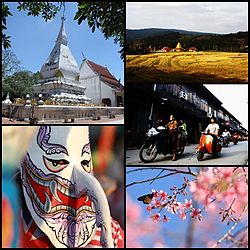Loei province
Loei (Thai: เลย, pronounced [lɤ̄ːj]), is one of the least populated provinces (changwat) of Thailand. It is in upper northeastern Thailand, also called Isan. Neighboring provinces are (from east clockwise) Nong Khai, Udon Thani, Nongbua Lamphu, Khon Kaen, Phetchabun, Phitsanulok. In the north it borders Xaignabouli and Vientiane Province of Laos.
|
เลย | |
|---|---|
 | |
|
| |
 Map of Thailand highlighting Loei Province | |
| Coordinates: 17°29′12″N 101°43′10″E / 17.48667°N 101.71944°ECoordinates: 17°29′12″N 101°43′10″E / 17.48667°N 101.71944°E | |
| Country | Thailand |
| Capital | Loei town |
| Government | |
| • Governor | Chaiwat Chuenkosum |
| Area | |
| • Total | 11,425 km2 (4,411 sq mi) |
| • Rank | Ranked 14th |
| Population (2018)[2] | |
| • Total | 642,773 |
| • Rank | Ranked 42nd |
| • Density | 56/km2 (150/sq mi) |
| • Rank | Ranked 72nd |
| Human Achievement Index | |
| • HAI (2017) | 0.5819 "average" Ranked 42nd |
| Time zone | UTC+7 (ICT) |
| Postal code | 42xxx |
| ISO 3166 code | TH-42 |
| Vehicle registration | เลย |
| Website | www |
As of 2020[update], the provincial governor is Chaiwat Chuenkosum.[4] The province was given 225.6 million baht in the FY2019 Thailand budget.[5]
History
Tradition says that Loei was created by people from Chiang Saen, the capital of Lan Na. Khun Pha Muang created the village of Dan-kwa, and Bang Klang Hao created Dan Sai. Drought and disease later made to the people move to the site of present-day Loei. In 1907 King Chulalongkorn (Rama V) created the Loei Province. The Loei Cultural Centre (ศูนย์วัฒนธรรมจังหวัดเลย) shows Loei's history, religions, and traditions.[6]
Geography
The land has many mountains. The seat of provincial government, Loei, is in a fertile basin where mountains are all around it. The most famous mountains in the province are Phu Kradueng, Phu Luang, and Phu Ruea. The Loei River, which flows through the province, is a tributary of the Mekong, which creates part of the northern border of the province with neighboring Laos. Phu Thap Buek, the tallest mountain of the Phetchabun Range, is in the province.[7]
The mountain Phu Kradueng is in Phu Kradueng National Park (อุทยานแห่งชาติภูกระดึง).[8]
The western part of the province reaches the southern end of the Luang Prabang Range mountain area of the Thai highlands.[9]
Economy
Agriculture is an important part of Loei's economy. Macadamia nuts, passion fruit, and Arabica coffee are grown in the highlands; bananas, sesame, and rubber are grown on the plains. Loei is a popular place for tourists who want to look at the environment. This is because of Loei's natural environment and amalgam of northern and northeastern cultures.[10]
Wang Saphung District has a big open pit gold mine that employs many people. The area has been the place of a long-standing disagreement as well as fights between the people of Ban Na Nong Bong and its environs and Tungkum Limited, a subsidiary of Tongkah Harbour PCL. Tungkum's gold mining work has been accused of environmental destruction in the courts.[11]
Government
Provincial government

|
The province is divided into 14 districts (amphoe). The districts are further divided into 89 subdistricts (tambons) and 839 villages (mubans).
Local government
As of 26 November 2019 there are:[12] one Loei Provincial Administration Organisation (ongkan borihan suan changwat) and 29 municipal (thesaban) areas in the province. Loei with Wang Saphung have town (thesaban mueang) status. Further 27 subdistrict municipalities (thesaban tambon). The non-municipal areas are governed by 71 Subdistrict Administrative Organisations - SAO (ongkan borihan suan tambon).[2]
Transportation
Route 201 comes from Chiang Khan in the north on the border with Laos. It goes through Loei, to Non Sa-at near Chum Phae. Route 203 leads west to the area of Phu Ruea, and then turns south to Lom Sak.
Loei Airport is the local airport.[13]
Symbols
The seal of the province shows the stupa at Phra That Si Song Rak, which was built in 1560 by King Maha Chakrapat of the Ayutthaya Kingdom and King Chai Chetha of Lan Xang. It was built as a symbol of friendship between the two kingdoms.[14] The provincial tree is the Khasi pine (Pinus kesiya).
The slogan of the province is "city of the sea of mountains, coldest place in Siam, with beautiful flowers of three seasons."[15]
Human achievement index 2017
| Health | Education | Employment | Income |
| 75 | 46 | 15 | 49 |
| Housing | Family | Transport | Participation |

|

|
||
| 24 | 16 | 56 | 16 |
| Province Loei, with an HAI 2017 value of 0.5819 is "average", occupies place 42 in the ranking. | |||
Since 2003, United Nations Development Programme (UNDP) in Thailand has watched progress on human development for the provinces using the Human achievement index (HAI). The HAI is a list including all the eight key areas of human development. National Economic and Social Development Board (NESDB) has taken over this job since 2017.[3]
| Rank | Classification |
| 1 - 15 | "high" |
| 16 - 30 | "somewhat high" |
| 31 - 45 | "average" |
| 45 - 60 | "somewhat low" |
| 61 - 77 | "low" |
| Map with provinces and HAI 2017 rankings |

|
Loei Province Media
Notes
Reports (data) from Thai government are "not copyrightable" (Public Domain), Copyright Act 2537 (1994), section 7.
References
- ↑ Advancing Human Development through the ASEAN Community, Thailand Human Development Report 2014, table 0:Basic Data (PDF) (Report). United Nations Development Programme (UNDP) Thailand. pp. 134–135. ISBN 978-974-680-368-7. Archived from the original (PDF) on 2019-08-01. Retrieved 17 January 2016, Data has been supplied by Land Development Department, Ministry of Agriculture and Cooperatives, at Wayback Machine.
{{cite report}}: CS1 maint: postscript (link) - ↑ 2.0 2.1 "รายงานสถิติจำนวนประชากรและบ้านประจำปี พ.ศ.2561" [Statistics, population and house statistics for the year 2018]. Registration Office Department of the Interior, Ministry of the Interior (in ไทย). 31 December 2018. Archived from the original on 14 June 2019. Retrieved 20 June 2019.
- ↑ 3.0 3.1 Human achievement index 2017 by National Economic and Social Development Board (NESDB), pages 1-40, maps 1-9, retrieved 14 September 2019, ISBN 978-974-9769-33-1
- ↑ "Loei governor rises as 'savior' in Covid-19 struggle". Thai PBS World. 2 May 2020. https://www.thaipbsworld.com/loei-governor-rises-as-savior-in-covid-19-struggle/. Retrieved 2 May 2020.
- ↑ Thailand's Budget in Brief Fiscal Year 2019. Bureau of the Budget. 20 December 2018. p. 95. Retrieved 2 May 2020.
- ↑ "Loei Cultural Center". Tourism Authority of Thailand (TAT). Archived from the original on 2 October 2018. Retrieved 5 June 2016.
- ↑ "Ban Thap Boek". Tourism Authority of Thailand (TAT). Archived from the original on 6 April 2016. Retrieved 6 May 2016.
- ↑ "Phu Kradueng National Park". Department of National Parks (DNP). Archived from the original on 21 January 2016. Retrieved 5 June 2016.
- ↑ ดร.กระมล ทองธรรมชาติ และคณะ, สังคมศึกษา ศาสนาและวัฒนธรรม ม.1, สำนักพิมพ์ อักษรเจริญทัศน์ อจท. จำกัด, 2548, หน้า 24-25
- ↑ "Loei: General Info". Tourist Authority of Thailand (TAT). Retrieved 5 June 2016.
- ↑ Wannasiri, Sutharee; Abbott, Kingsley (2016-06-05). "Struggle against mining violations leaves activists exposed". Bangkok Post. http://www.bangkokpost.com/opinion/opinion/1002137/struggle-against-mining-violations-leaves-activists-exposed. Retrieved 5 June 2016.
- ↑ "Number of local government organizations by province". dla.go.th. Department of Local Administration (DLA). 26 November 2019. Retrieved 10 December 2019.
54 Loei: 1 PAO, 2 Town mun., 27 Subdistrict mun., 71 SAO.
- ↑ "Loei Airport". OurAirports. Archived from the original on 3 May 2015. Retrieved 3 February 2013.
- ↑ "Loei". THAILEX Travel Encyclopedia. Retrieved 5 June 2016.
- ↑ "About Loei". Tourist Authority of Thailand (TAT). Archived from the original on 16 April 2016. Retrieved 5 June 2016.
Other websites
| Wikimedia Commons has media related to Lua error in Module:Commons_link at line 62: attempt to index field 'wikibase' (a nil value).. |
 Loei travel guide from Wikivoyage
Loei travel guide from Wikivoyage- Provincial website
- Local website of Loei (Thai version) : Outloei.com




